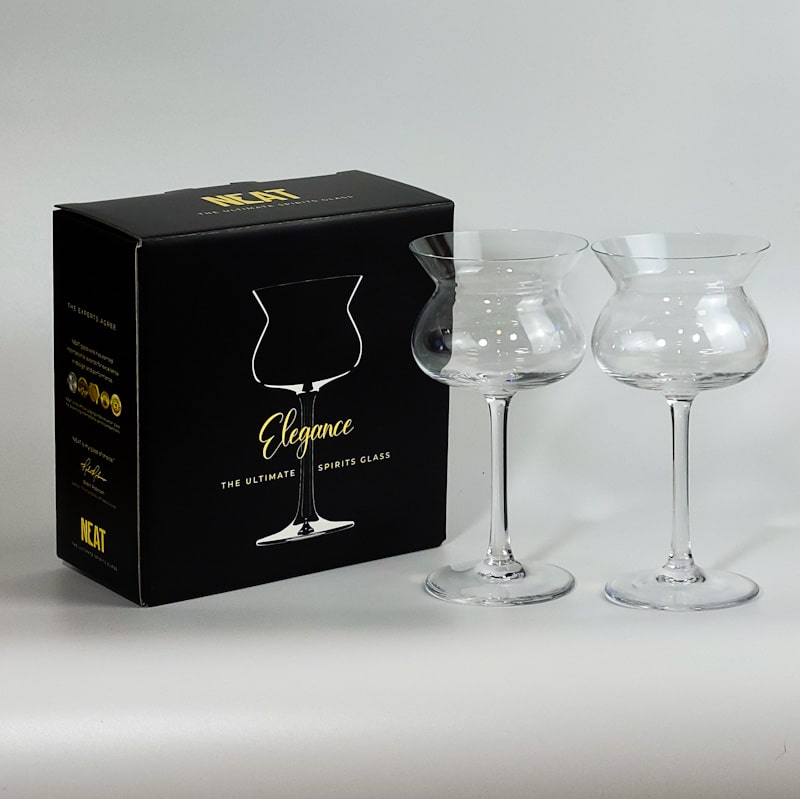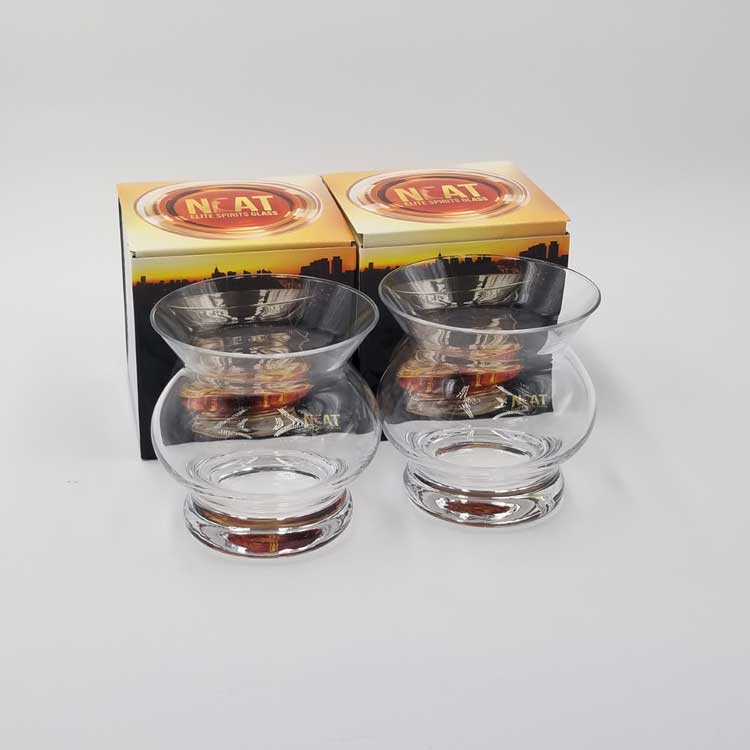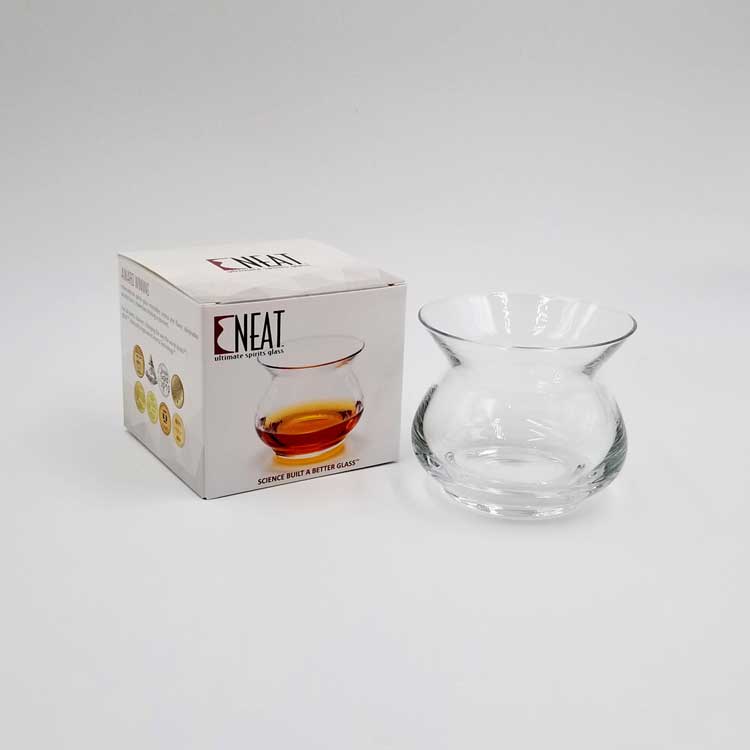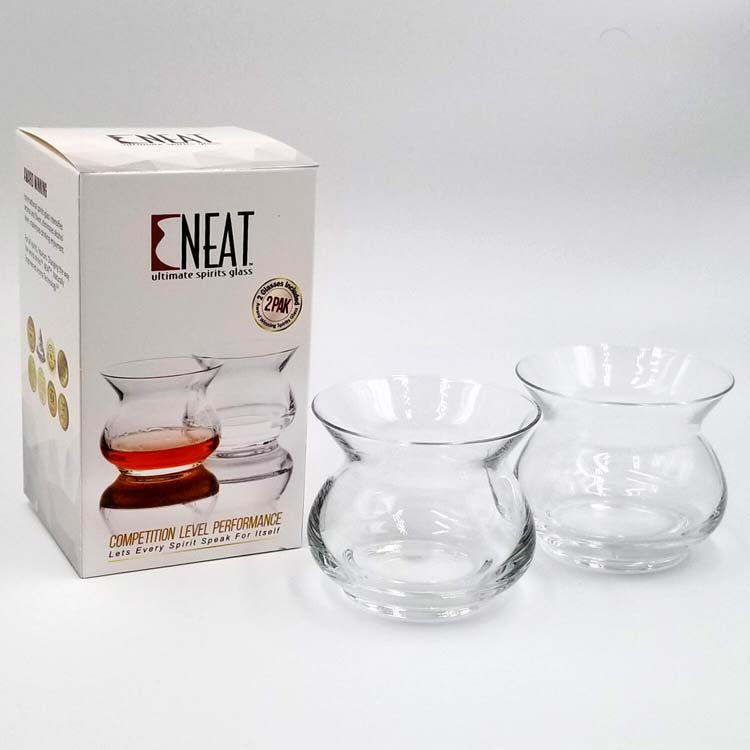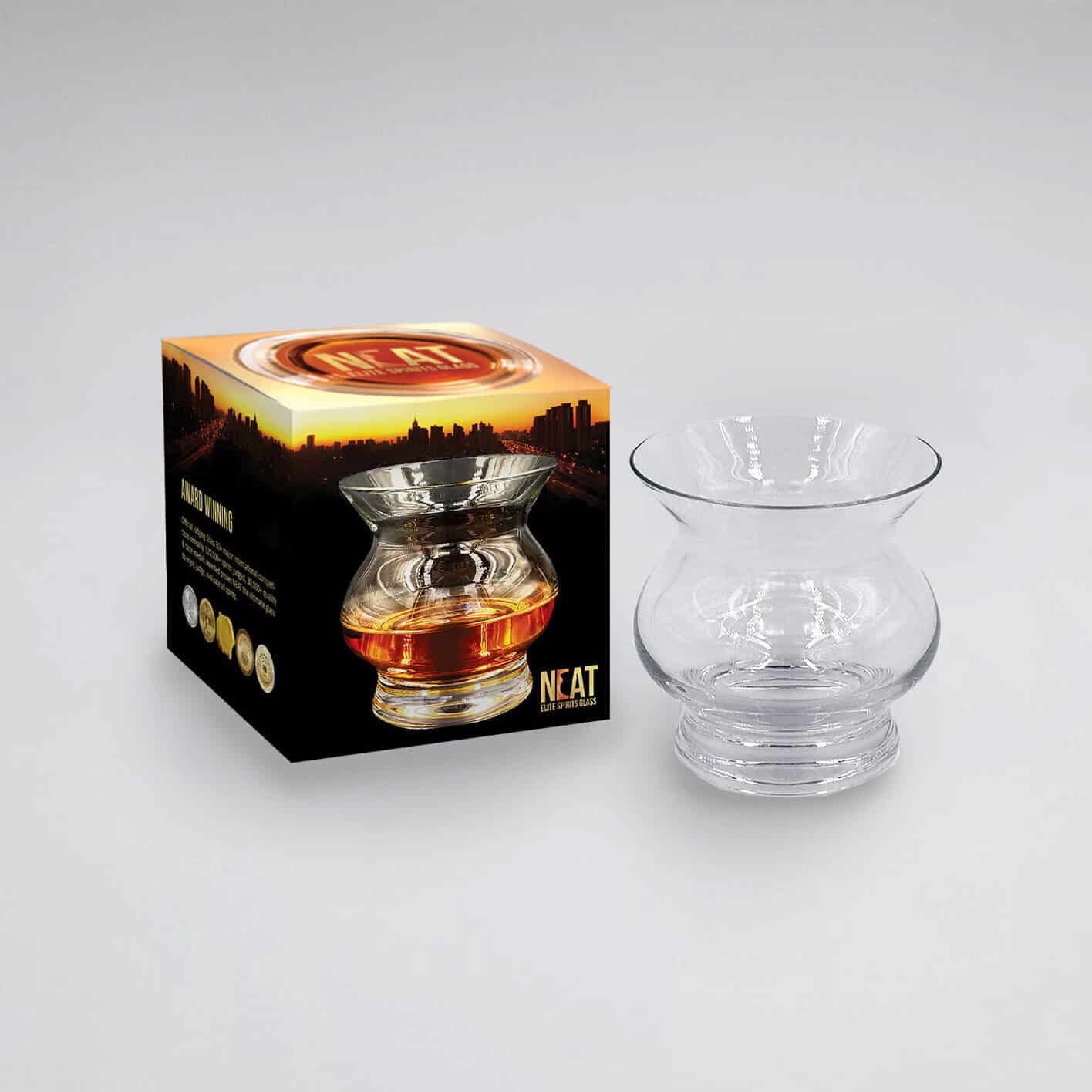
A New Concept – Manipulating Aroma Diffusion for Diagnostics
Within the spirits industry, particularly in scotch whisky, game-changing personalities emerged to make major contributions to the tasting and evaluation of spirits: Michael Jackson and Jim Murray may be the most definitive of the early pioneers in scotch, and certainly, Richard Paterson takes the lead in providing widespread scotch whisky education. Much of the present state of evaluation for all spirits comes from their publications and seminars.
These pioneers had no exposure or familiarity with sensory science, which evolved later into an established discipline used extensively today by many corporations to validate their spirits products. The pioneers’ intuition and judgment have guided the spirits industry for several decades and their influence on public taste preferences cannot be minimized. Their spirit vessel of choice was the copita, the traditional dock glass borrowed from Spanish sherry (a fortified wine) in the late 1700s. Later came the Glencairn, an admitted derivative of the copita, which is now considered a standard tool, at least from the standpoint of the spirits drinkers’ iconic identification badge.
The preceding two presentations on the functionality of common spirits glass designs will no doubt be controversial to those who have been entrenched in the tulip and snifter camps for years. Avoiding ethanol is not a new issue among evaluators, but pointing to the glassware as the major source of the problem is a bold and unprecedented event, bound to upset those who resist change or doubt science, or prefer the unique styling of their current favorite glass. The results of over 18 years of research prove that glassware design is a culprit which contributes significantly to ethanol anesthesia, but can also be engineered into a solution to the problem.
A discovery in 2002 changed the dynamics of glass design for spirits evaluation: Applying engineering and physics to modify glass design eliminates ethanol nose burn and anesthesia. Adding a neck to the glass forces the molecules to converge rapidly in search of the quickest escape route out of the glass to freedom. This is the same occurrence for all tulips, copitas, and snifters with convergent sides and small rim plane areas. The congestion of molecular collisions is the same at the rim plane and the neck of the engineered glass, but what happens after the molecules diffuse out of the rim/neck concentration is the game changer.
Designing a controlled expansion space above the neck regulates containment as the aromas diffuse through the neck and position themselves based on molecular weight velocity of dispersion, and molecular complexity (such as long-chain esters). This expansion space is contained horizontally by a large flared, straight rim that controls aroma dissipation throughout the rim plane from light to heavy, separating faster-moving, lighter nose-numbing ethanol from the heavier character aromas of any spirit.
This discovery, perfected in size and flare angle over 10 years of research by Arsilica, Inc, resulted in the release of the NEAT glass in 2012. Introducing a controlled, gradual expansion into the diffusion space manipulates aroma diffusion, proving to be a distinct advantage for spirits evaluators by minimizing exposure to nose-numbing ethanol as those aroma molecules diffuse quickly over the rim edge, away from the aroma detection area.
Over 30 major competitions now use NEAT as their official judging glass, beginning in 2013, and not a single instance of ethanol anesthesia, olfactory fatigue, or nose-blindness has occurred during the fast pace of competition judging. As of mid-2020, over 120,000 spirits have been judged in official spirits competitions, and over 30,000 quality medals have been awarded to spirits judged and evaluated in the NEAT glass. NEAT has proven to be a viable alternative to the three common glass shapes by detecting and identifying more aromas, significantly reducing ethanol concentration, and placing the nose in a position to begin orderly aroma detection.
More detail on how it works: Small rim areas concentrate ethanol, especially if those areas are smaller than the area of the liquid surface in the bowl. Evaporating aromas are forced upward by the constant evaporation of more molecules, and the lighter aromas move the quickest, crowding the tiny rim area and filling any available space to escape the glass through the narrow opening.
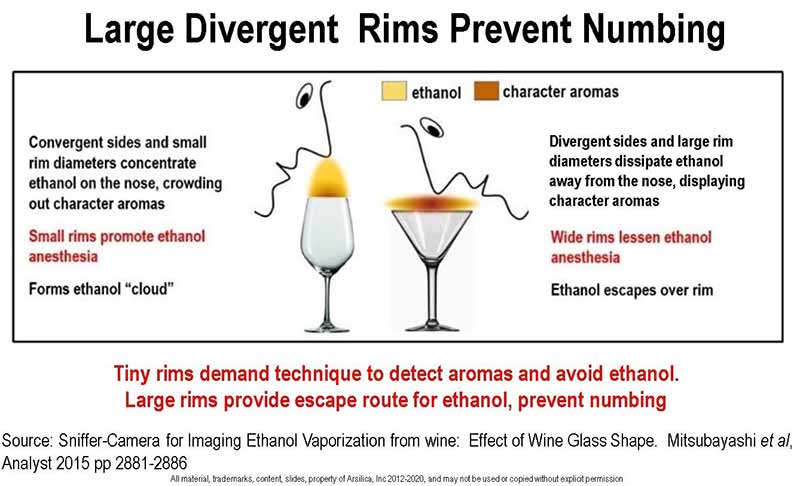
By taking the most useful portion of each design (convergent sides and divergent sides), we created a new shape with a large bowl for swirling and a neck to concentrate the abundant aromas released through swirling. The neck concentrates and stimulates molecular collisions which increases molecular velocities. Instead of dissipating molecules into the atmosphere randomly (as with tulip, copita, and snifter shapes), we add a large divergent rim, similar to a cocktail glass to control dispersions as the molecules continue their upward direction..
In the space between the neck and the top rim, the controlled expansion provides a path for lighter ethanol to quickly make its way to the rim edge, and the heavier character aromas dissipate slower, to be detected by the nose without the presence of nose-numbing ethanol. A key design relationship is the neck cross-sectional area, to the upper rim edge cross-sectional area, as this ratio, as well as the rim plane height above the neck, controls the exact dissipation of available aromas.
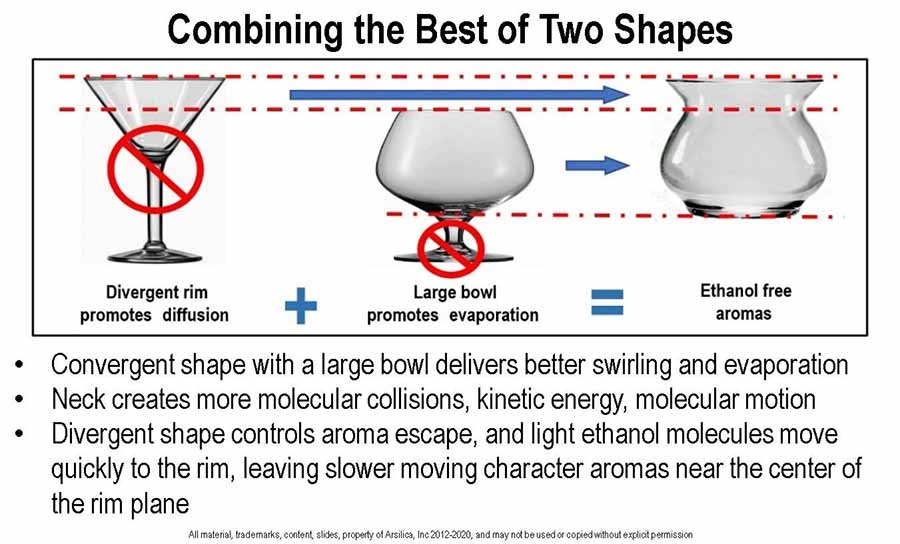
In a previous presentation, we determined that shorter glasses pick up more aromas. Using a typical evaporation curve of a heavier aroma, we can see that shorter heights can increase the opportunity to detect character aromas. In this instance, the area of highest concentration is at the rim of the tulip glass, and the neck of the NEAT glass. The reduction in height allows more aromas to reach the neck for further dissipation to the rim plane.
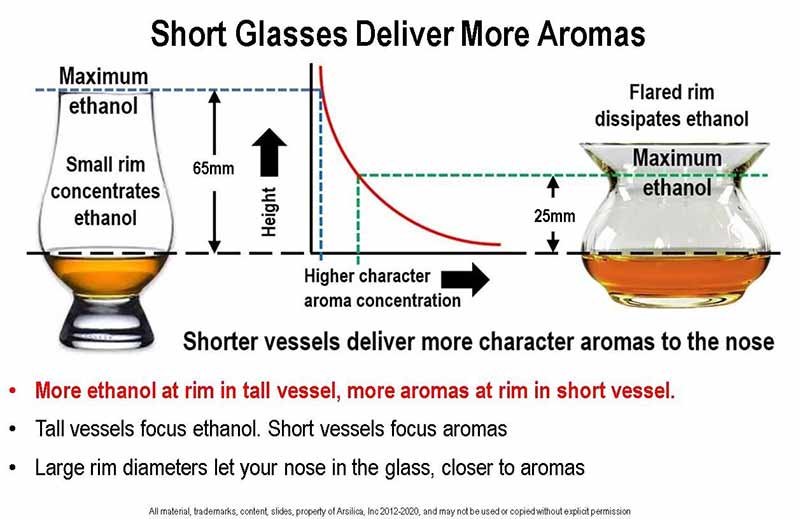
A major complaint of tulip glasses is the restricted, small area rim which prevents the nose from entering the aroma cloud. Designing the rim plane large enough to allow the nostrils to access the center of the expanded aroma cloud maximizes the opportunity to pick up more aromas. By designing the glass to fit the average nose, we find that placing the lips on the glass rim positions the nose automatically in the center of the rim plane.
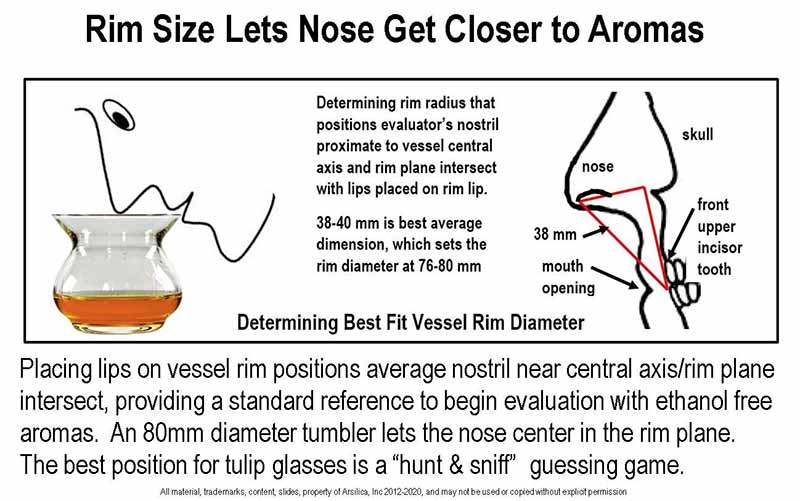
When all of these issues are dealt with, the result is a short glass to pick up more aromas, a fat and wide bowl to enhance swirling, a large area to accommodate the nose, and ethanol is separated from the character aromas and dispersed from detection while analyzing character aromas.
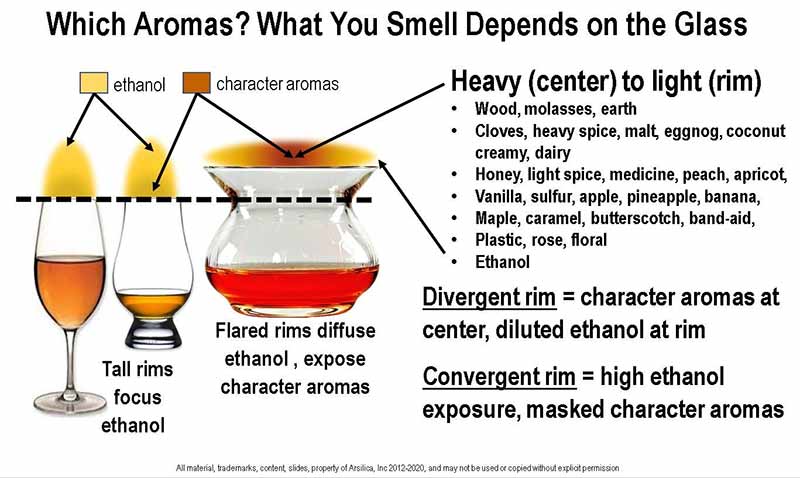
A little engineering, common sense, and focused attention to the laws of physics can go a long way toward enhancing personal satisfaction and improving spirits buying and collecting. Do we think this is the ultimate in glassware design? For now, it is by far the superior tasting, nosing, and evaluation glass, but we never underestimate the power of science-based discovery as we continue to encourage new ideas and search for better ways to improve the evaluation and enjoyment of all spirits.
For decades after the introduction of refrigerators, automobiles, and the cooking range, doubters and those who cling to tradition chose to be loyal to the iceman, horses, and woodstoves. Getting used to new ideas is hard for some, and no doubt the NEAT glass is experiencing the same resistance from those unwilling to quickly embrace change. It is all part of the process of evolution as science and discovery replace the myths and all contrived devices of the past which left room for improvement.
Takeaway: Dissipating ethanol away from the nose exposes all aromas, both good and bad, and puts the evaluator in the driver’s seat by prioritizing aromas and personal quality assessment over-reliance on suggestive advertising. Nothing can hide from approval or disapproval, placing the evaluator in control to discover and choose personal flavor nuances using an engineered glass as a decision-making tool. See how independent research shows the NEAT glass is superior to all others.
In our next presentation, we will explore how a professional independent sensory analysis group compares two of the basic shapes vs the engineered glass. Then we will move on to the finer points of nosing, evaluation, and personal sensory development.

